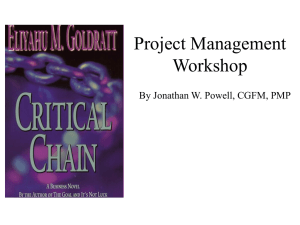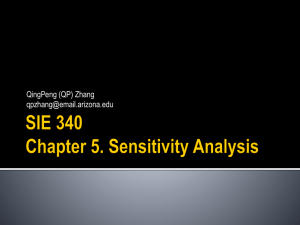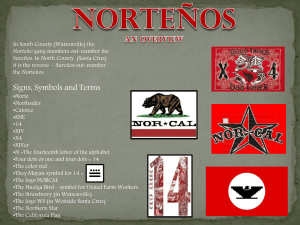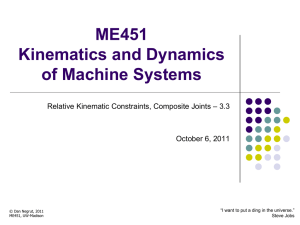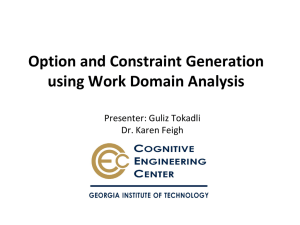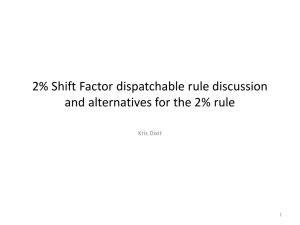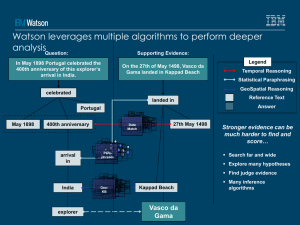revealed answers
advertisement
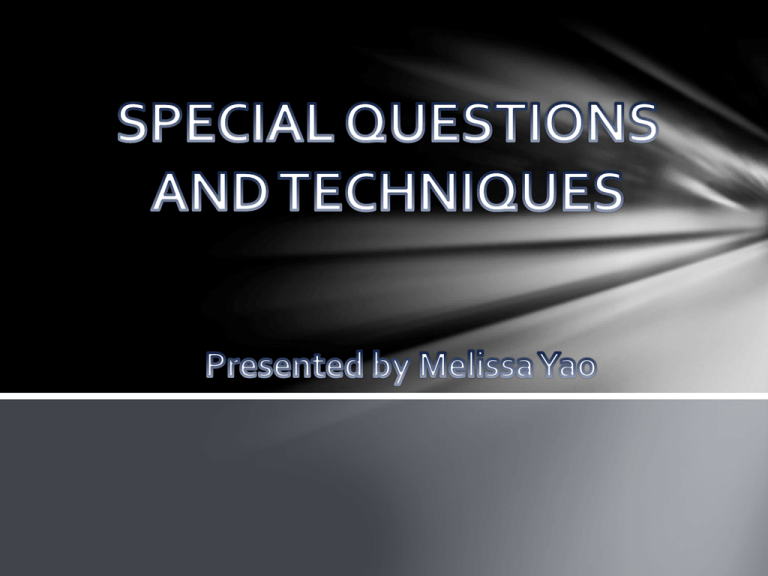
• Most Jeopardy questions are Standard Questions, consisting of statements expressing one or more assertions about an entity or concept, which remains unidentified in the question text. • Special Jeopardy! Questions require a specialized computational procedure. • Puzzle • Multiple Choice • Common Bond • Fill-in-the-Blank • Constraint Bearing • Pun Bearing • Will sometimes comprise 1/6th of the Jeopardy round. • There are three general techniques that are broadly applicable across questions types. • 1. Question decomposition and answer synthesis – a subset of Puzzle questions require decomposition into parts, solution of parts, and then an algorithmic recombination into candidate answers. • 2. Use of hints such as lexical constraints and puns – Lexical constraints and puns describe characteristics of the answer. Not useful when searching for candidate answers but very useful when evaluating them. • 3. Category-based revealed-answer learning – Answers obtained by referring to answers that have already been revealed in the given category. • Many Puzzle questions, including all Before & After and most Rhyme Time questions, require decomposition for successful solution • Ex. The “Jerry Maguire” star who automatically maintains your vehicle’s speed. (Answer: “Tom Cruise control”) • Is a made-up phrase that is extremely unlikely to be found in any reference source and therefore is generated by performing two separate searches and combining the results. • Matching manually developed Prolog rules against the question’s predicate-argument structure to identify its subparts (SubQuestionSpans) • SubQuestionSpans are used to generate intermediate candidate answers called precandidates. • Precandidates are brought together in a synthesis stage to form final candidate answers. • Many Jeopardy! Questions contain hints to the answer in the form of lexical constraints and puns. • Lexical constraints – requirements that the answer be a certain number of letters or words long; or begin with, end with, or contain certain letters or letter sequences; rhyme with a certain word; or have other lexical properties. [13%] • Puns – play on words; exploitation of different possible meanings of a word or the fact that there are words that sound alike but have different meanings. [1%] • These properties are used to score existing candidate answers on the basis of their degree of match with the recognized element. • • • • • Might be instantiated as such: • Ex.) STARTS & ENDS WITH “A”: In 1981 this country acted as go-between to secure the release of the 52 Americans held by Iran. (Answer: “Algeria”) Or only partially instantiated: • Ex.) ONLY ONE VOWEL: Proverbially, you can be “flying” this or be this “and dry”. (Answer: “high”) Vague or ambiguous Not always strictly English • Ex.) THE L”ONE”LIEST NUMBER, IN THE “GN”OW Will use patterns common to previously revealed answers to evaluate the question. Developed an inference process that complements the recognition process. • Constraint processing is handled by the Constrainer component, which consists of constraint classes and management infrastructure. Each constraint class handles a different kind of constraint and has the following capabilities: • 1) Recognition and instantiation of a constraint class from the question • 2) Inference of a constraint class from revealed answers in the same category. • 3) Testing a candidate for passing or failing the constraint. • Constraint classes are manually developed to cover the most common cases of lexical constraints. • Constrainer process is run after question analysis, and every constraint object analyzes the question to see if it should become active. • Each candidate answer is tested by the ActiveConstraintSet and is given features to indicate whether no lexical constraints exist for this question or whether it passed or failed if constraints are identified. • Only type of pun that Watson will attempt to solve is the form of a quoted phrase modifying the question focus. • 1) SUBSTRING: SLOGANEERING: In 1987 using the slogan “Catch the wave”, Max Headroom pitched this “new” soft drink (Answer: “New Coke”) • 2) SYNONYM: GEOLOGY: Due to its luster, German miners gave this “pleasant” rock its name, which means “spark”. (Answer: “gneiss”, whose homophone “nice” is a synonym of “pleasant”) • 3) INSTANCE: F: An opera from 1900 gave wing to this popular “insect” composition by Rimsky-Korsakov. (Answer: “Flight of the Bumblebee”) • 4) ASSOCIATION: I DO KNOW JACK: Marilyn Monroe made her major TV debut in 1953 on this “stingy” comedian’s TV show (Answer: “Jack Benny”) • Jeopardy! provides a form of feedback within a category by making the correct answer available to the players after each question is played • Watson uses these revealed answers to improve its analysis results, such as for lexical answer type (LAT) detection and identifying certain category-question relationships. • Revealed-answer constraint learning allows Watson to infer a constraint that was missed when analyzing the category or to remove a constraint that was incorrectly detected or inferred for the category. • A constraint object inferred on the basis of revealed answers must satisfy the following two conditions: • 1) The constraint object must pass all answers so far revealed in the category. • 2) The a priori probability of this constraint is low enough for Watson to confidently hypothesize the presence of the constraint. (Threshold of 96%) • In Table 2, examples of learning of both a lexical constraint and a Puzzle type can be seen that occurred during the Watson development period • Column 4 gives the probability that the constraint/question type is in play at this point, assuming the a top-to-bottom order of question selection, and column 5 indicates whether that probability exceeded the threshold and whether the constraint/type was triggered. • Revealed-answer learning is in place for two reasons: • 1) to react to situations that have been observed in training data and for which programmed mechanisms are in place, but because of unexpected phraseology in test data, the occurrences are not recognized. • 2) bugs or other deficiencies in the recognition process. • Processing of three of the most common Special Jeopardy! Question types: Puzzle, Multiple Choice, and FITB. • Questions for which one would not expect any text corpus to contain the answer along with the facts asked about the question. Instead, the answer must be constructed. • Types include Math, Before & After, Rhyme Time, Anagram, and Hidden Words. • Focus on how candidate answers are generated • ANAGRAMS: It’s the only kitchen appliance Rosetta knows how to use (Answer: “toaster”) • “Toaster” is not the only anagram of one of the question words, but it is the only one that is an instance of the LAT “appliance”; therefore, only it will generate a good TyCor score. • Are made-up phrases that do not naturally occur in any text and must be synthesized. • Before & After questions always contain definitions or descriptions of two different entities that must be overlapped to give the answer. • Rhyme Time questions contain definitions or descriptions of two different entities that must rhyme. • BEFORE & AFTER: 1961 invasion of Cuba wrapped in a tasty pastry. (Answer: “Bay of pigs in a blanket”) • AUTHORS’ RHYME TIME: Ian’s Scandinavian rodents. (Answer: “Fleming’s lemmings”) • To solve these questions, the system runs Hypothesis Generation on each SubQuestion Span to generate the precandidates and then synthesizes final candidate answers. • 1) MATH CLASS: It’s the square root of the square root of 16. (Answer: “2”) • Evaluated by a Definite-Clause Grammar (DCG) that parses the expression and produces a parse tree. • 2) GEOMETRY: If 3 angles in a quadrilateral are 40º, 140º, and 80º then the other angle must be this many. (Answer: “100”) • Evaluated by a component consisting of approximately 20 geometrical and arithmetic objects and a similar number of formulas relating values of these objects to a computed result • 3) YOU DO THE MATH: the number of legs on a spider plus the number of legs on a fly. (Answer: “14”) • Perform a lookup that returns a ratio between two units of measurements. If that approach fails, a search engine against an n-gram corpus is used to identify the integer most closely associated with the terms in a question. • Answers to Anagrams and Hidden Words can be found in either 1) titles of Wikipedia documents or 2) entities found in the instance lists maintained by Watson’s entity recognizer. • This enables Watson to use a generate-and-test regimen. • In Anagrams, Watson tests to determine the section of the question that provides the anagram letters: • The entire question, if it is less than a certain length. • The span that precedes or follows a colon to the beginning or end of the question, if less than a certain length. • Any word or quoted phrase in the question. • In Hidden Words questions, the answer is a word formed from letters that appear consecutively in the question, but not necessarily as a word and are assumed to cross word boundaries. • Watson must detect the Multiple Choice question, identify each of the answer choices, and then use the rest of the category or question text to select the best answer. • Sets each choice as a candidate choice and ranks it as such. • Watson solves a FITB question by first detecting the FITB question during question analysis and identifying the missing portion of the quote or phrase that must be found. • Watson then runs the rest of the FITB processing as a candidate answer generator, operating on the results of primary passage search. • Lists and ranks candidate answers. • Special Question processing was evaluated giving Watson a blind test set of 3,571 questions while also manually annotating the types of questions. The results can be seen in Table 3 • Question-answering accuracy of the more common Puzzle types was evaluated on a different blind set of 10,000 questions. • Failure analysis of 184 Before & After questions from a sample of 30,000 sample questions reveals the failure causes in Table 4. • To evaluate the impact of the Constrainer component, it was ablated from the system, all models were retrained, and this “baseline” system was run on the test set of 3,571 blind questions. The results are reported in Table 5. • Experiment to measure to what extent revealed learning could compensate for recognition deficiencies without hurting performance with overaggressive influence. • Established the following: • The last question in the category • The correct answer. • A manually constructed answer of the type expected by the question, but not observing the stated constraint. • Forwards Constrainer generated by analysis of the category string and Inferred Constrainer from the revealed answers. • Measured to what extent these constrainers individually and combined passed the correct answer and failed the wrong answer. • Lost one correct answer but rejected 16 wrong answers that the Forwards Constrainer had passed. • Special Questions are a very small fraction of all Jeopardy! Questions, but will often occur as entire categories, representing one sixth of an entire round. • Needed to develop special algorithms to deal with and solve Special Questions.
